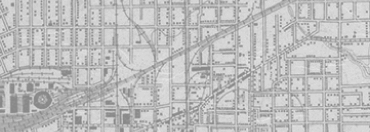


Back
Presidential lap robe from the Kennedy limousine the day of the assassination
Lap robe from President Kennedy's limousine the day of the assassination, November 22, 1963. This lap robe is made of a navy wool with the official presidential seal embroidered in the middle in gold, red, white, blue, black, green, and brown threads. It has a grey fabric lining, snaps along the edges, and is 51" long by 41 1/2" wide. The fabric of the lap robe was folded and wrapped around a pole in a custom door compartment of the presidential limousine, snapping into place, with the seal facing towards the interior of the car. There were matching lap robes in identical compartments on either side of the vehicle. The lap robes were meant to be removed and used to keep warm in cold temperatures. On November 22, 1963, Governor John Connally and his wife, Nellie Connally, would have been seated next to the compartments where these blankets were stored.
Presidential lap robe from the Kennedy limousine the day of the assassination
1960 - 1963
Cloth, Fibers, Man-made, Metal
50 1/2 × 41 in. (128.3 × 104.1 cm)
The Sixth Floor Museum at Dealey Plaza Collection
2015.026.0001
Object featured in special exhibition, Two Days in Texas, November 8, 2023 through September 8, 2024.
The lap robes are visible in a number of photos of the presidential motorcade through Dallas on November 22, 1963, including a photo by Dallas Morning News chief photographer Tom Dillard that shows the empty limousine waiting at Love Field (1994.003.0002.0002), which you can see here: https://emuseum.jfk.org/objects/11774. - Stephanie Allen-Givens, Collections and Exhibits Manager
The Lincoln Continental presidential touring limousine, designated the SS-100-X, was the first of its kind. Prior to this car, the president's vehicles used in motorcades had been stock automobiles. Planning for this customized limousine began in 1957, and assembly commenced on March 3, 1961. A standard Lincoln Continental at the time cost around $7,350. Presidential customizations raised the total cost to approximately $200,000, or more than $1,700,000 in 2021 dollars. Hess and Eisenhardt of Cincinnati, Ohio, made the conversion to this parade touring car by cutting a standard Lincoln four-door convertible in half and extending it three and a half feet. The vehicle could be transformed from an open-top convertible into a semi-closed or fully-closed automobile using a series of detachable steel and transparent roof panels (commonly called "the bubbletop") and a cover. Other upgrades made to the vehicle included the installation of a hydraulic backseat that could elevate the president up to ten and a half inches, a custom heating and air conditioning system with dual control panels, retractable steps for Secret Service agents, flashing red lights, a siren, dual flagstaffs, fold-down jump seats for two additional passengers, two radio telephones and two hand-embroidered presidential lap robes housed in custom door pockets. Designers selected the color midnight blue for the vehicle, which was delivered to the White House garage on June 14, 1961 and was frequently used for presidential parades, including during a visit to Tampa, Florida just four days prior to the assassination. After the assassination, the SS-100-X was loaded aboard a C-130 military transport plane and flown to Andrews Air Force Base where Secret Service agents took the car to the Secret Service garage. Investigators spent the next month examining the vehicle, during which time the upholstery was cleaned, and the windshield was removed. By late December, investigators had finished with the vehicle, though its fate was uncertain. A government panel convened to discuss the matter, with some suggesting that the car should be destroyed or stored indefinitely. However, there was not another custom presidential touring car like it, and it was determined that it would take years (and great cost) to develop a new presidential limousine. It was simply faster and less expensive to strip the SS-100-X to its frame and rebuild it, which involved encasing the body in armor and titanium plating and adding a permanent bulletproof hard-shell roof. Five-layer bulletproof windows were also installed. In total, the vehicle's weight increased nearly 2,000 pounds. The presidential limousine returned to service for use by President Lyndon Johnson on May 11, 1964. It was still painted midnight blue, but at Johnson's request, the Secret Service repainted the vehicle black. The car ultimately served five presidents, John F. Kennedy to Jimmy Carter, and was retired from service in May 1977. It was returned to Ford, who had leased the car to the Secret Service for $500 per year, and it is now displayed at the Henry Ford Museum of American Innovation in Dearborn, Michigan. The two presidential lap robes were removed from the vehicle and cleaned by White House chauffeurs in December 1963. Secret Service agent L.P. Boggs, assistant director of motor vehicle operations, later presented this lap robe to Ford employee Burke Reilly, who worked at the company's Washington Affairs Office. Reilly worked closely with several agents during his career and developed many friendships. Reilly recorded an oral history with the Museum in 2009. Because it was quite common (prior to the assassination) for presidents to travel in open top convertibles during parades, vehicle lap robes similar to this actually date back to at least the Herbert Hoover administration, 1929 to 1933. According to Burle Reilly, only two lap robes were made for the SS-100-X. -- Stephen Fagin, Curator
Presidential lap robe from the Kennedy limousine the day of the assassination
Lap robe from President Kennedy's limousine the day of the assassination, November 22, 1963. This lap robe is made of a navy wool with the official presidential seal embroidered in the middle in gold, red, white, blue, black, green, and brown threads. It has a grey fabric lining, snaps along the edges, and is 51" long by 41 1/2" wide. The fabric of the lap robe was folded and wrapped around a pole in a custom door compartment of the presidential limousine, snapping into place, with the seal facing towards the interior of the car. There were matching lap robes in identical compartments on either side of the vehicle. The lap robes were meant to be removed and used to keep warm in cold temperatures. On November 22, 1963, Governor John Connally and his wife, Nellie Connally, would have been seated next to the compartments where these blankets were stored.
Presidential lap robe from the Kennedy limousine the day of the assassination
1960 - 1963
Limousine
U.S. presidents
Motorcade
Trip to Texas
Kennedy, John F.
White House
Fort Worth Chamber of Commerce
Washington, D.C.
Dallas
Cloth, Fibers, Man-made, Metal
50 1/2 × 41 in. (128.3 × 104.1 cm)
The Sixth Floor Museum at Dealey Plaza Collection
2015.026.0001
Object featured in special exhibition, Two Days in Texas, November 8, 2023 through September 8, 2024.
The lap robes are visible in a number of photos of the presidential motorcade through Dallas on November 22, 1963, including a photo by Dallas Morning News chief photographer Tom Dillard that shows the empty limousine waiting at Love Field (1994.003.0002.0002), which you can see here: https://emuseum.jfk.org/objects/11774. - Stephanie Allen-Givens, Collections and Exhibits Manager
The Lincoln Continental presidential touring limousine, designated the SS-100-X, was the first of its kind. Prior to this car, the president's vehicles used in motorcades had been stock automobiles. Planning for this customized limousine began in 1957, and assembly commenced on March 3, 1961. A standard Lincoln Continental at the time cost around $7,350. Presidential customizations raised the total cost to approximately $200,000, or more than $1,700,000 in 2021 dollars. Hess and Eisenhardt of Cincinnati, Ohio, made the conversion to this parade touring car by cutting a standard Lincoln four-door convertible in half and extending it three and a half feet. The vehicle could be transformed from an open-top convertible into a semi-closed or fully-closed automobile using a series of detachable steel and transparent roof panels (commonly called "the bubbletop") and a cover. Other upgrades made to the vehicle included the installation of a hydraulic backseat that could elevate the president up to ten and a half inches, a custom heating and air conditioning system with dual control panels, retractable steps for Secret Service agents, flashing red lights, a siren, dual flagstaffs, fold-down jump seats for two additional passengers, two radio telephones and two hand-embroidered presidential lap robes housed in custom door pockets. Designers selected the color midnight blue for the vehicle, which was delivered to the White House garage on June 14, 1961 and was frequently used for presidential parades, including during a visit to Tampa, Florida just four days prior to the assassination. After the assassination, the SS-100-X was loaded aboard a C-130 military transport plane and flown to Andrews Air Force Base where Secret Service agents took the car to the Secret Service garage. Investigators spent the next month examining the vehicle, during which time the upholstery was cleaned, and the windshield was removed. By late December, investigators had finished with the vehicle, though its fate was uncertain. A government panel convened to discuss the matter, with some suggesting that the car should be destroyed or stored indefinitely. However, there was not another custom presidential touring car like it, and it was determined that it would take years (and great cost) to develop a new presidential limousine. It was simply faster and less expensive to strip the SS-100-X to its frame and rebuild it, which involved encasing the body in armor and titanium plating and adding a permanent bulletproof hard-shell roof. Five-layer bulletproof windows were also installed. In total, the vehicle's weight increased nearly 2,000 pounds. The presidential limousine returned to service for use by President Lyndon Johnson on May 11, 1964. It was still painted midnight blue, but at Johnson's request, the Secret Service repainted the vehicle black. The car ultimately served five presidents, John F. Kennedy to Jimmy Carter, and was retired from service in May 1977. It was returned to Ford, who had leased the car to the Secret Service for $500 per year, and it is now displayed at the Henry Ford Museum of American Innovation in Dearborn, Michigan. The two presidential lap robes were removed from the vehicle and cleaned by White House chauffeurs in December 1963. Secret Service agent L.P. Boggs, assistant director of motor vehicle operations, later presented this lap robe to Ford employee Burke Reilly, who worked at the company's Washington Affairs Office. Reilly worked closely with several agents during his career and developed many friendships. Reilly recorded an oral history with the Museum in 2009. Because it was quite common (prior to the assassination) for presidents to travel in open top convertibles during parades, vehicle lap robes similar to this actually date back to at least the Herbert Hoover administration, 1929 to 1933. According to Burle Reilly, only two lap robes were made for the SS-100-X. -- Stephen Fagin, Curator













